NEC PA271W - When Accuracy and Consistency Matter
by Chris Heinonen on May 1, 2012 1:55 PM ESTNEC PA271W - Color Quality and Color Gamut
Targeted directly at designers and other graphics professionals, we’d expect to see excellent performance, hopefully before and after calibration from the NEC. For the initial measurements, with so many options available, I used the included ICC profile and set the monitor to sRGB mode as well as 200 nits of light output.
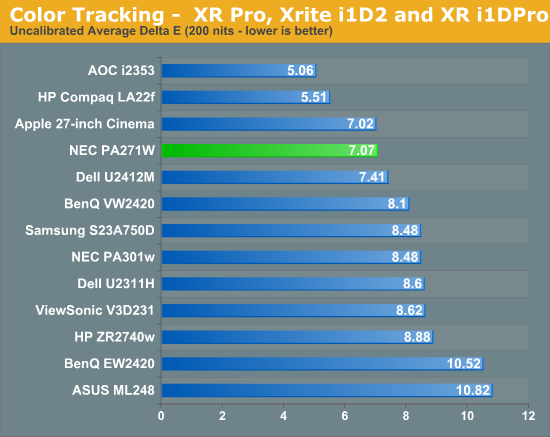
Pre-calibration we get an error of 7.07, which is a bit higher than I thought it would be, with a really high error in the grayscale. Overall this was OK, but I highly doubt many people will buy this display without choosing to calibrate it given its target market. Our target settings were a 2.2 gamma, D65 white point, and 200 nits of light output. ColorEyes Display Pro doesn’t give a color gamut option, so I assume it is targeting the native gamut of the display.
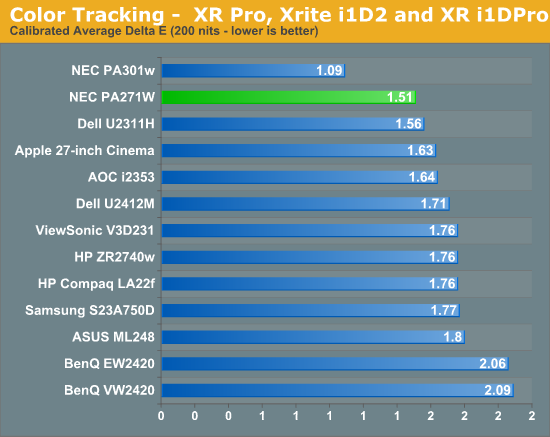
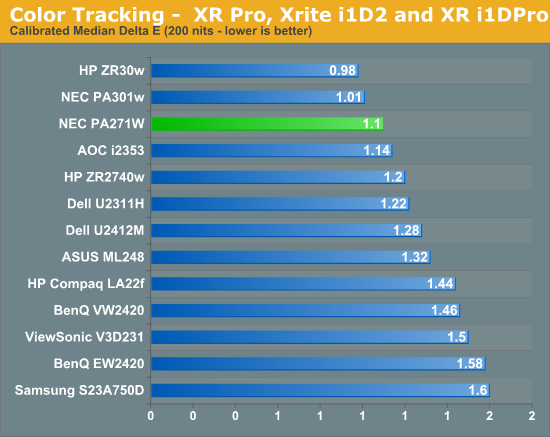
This is much better after a calibration, with an average dE of only 1.51 and a median dE of just under 1.1. You’ll notice the last color sample before pure white, a turquoise blue, has a much lower error here than on most displays. This is the shade of blue that actually lies outside of the sRGB colorspace and so most displays cannot reproduce it, leading to a very high dE there. The only panel to do better recently is the 30” NEC that has a true 10-bit panel.
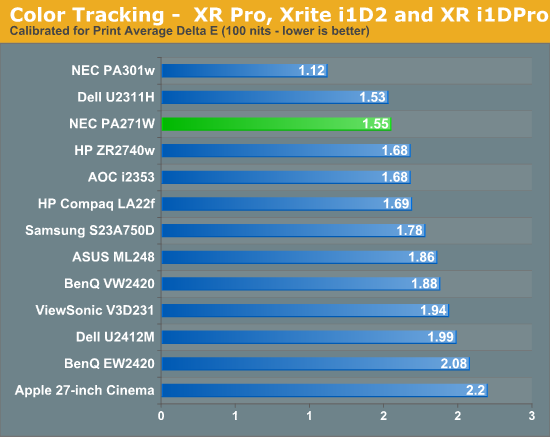
As the print market is a main area for NEC to target with this display, its performance with 100 nits of light output is of more importance than usual. Here we find that the NEC performs almost identically to its 200 nits results, which is actually quite good. As many displays get better or worse as the light output changes, that indicates they will only perform at their best at a certain light level, whereas if you are consistent the user can set the light to match their environment. The NEC doesn’t run away from the competition in any of these tests, but it performs very well, and very consistently.
You won't be lacking for gamut here either, as the NEC covers over 109% of the AdobeRGB gamut, meaning that for any work you are doing, even including something like DCI Cinema, the NEC has you covered.
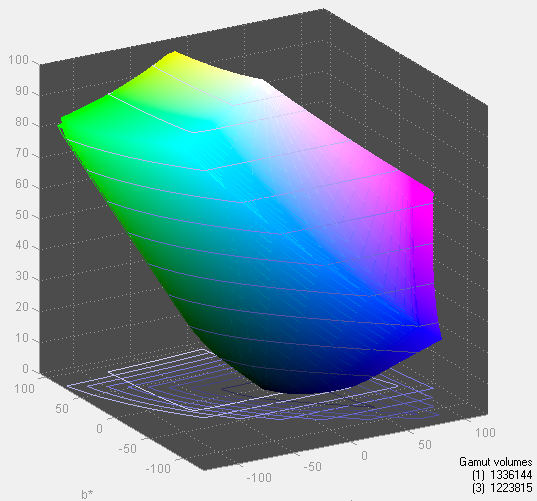
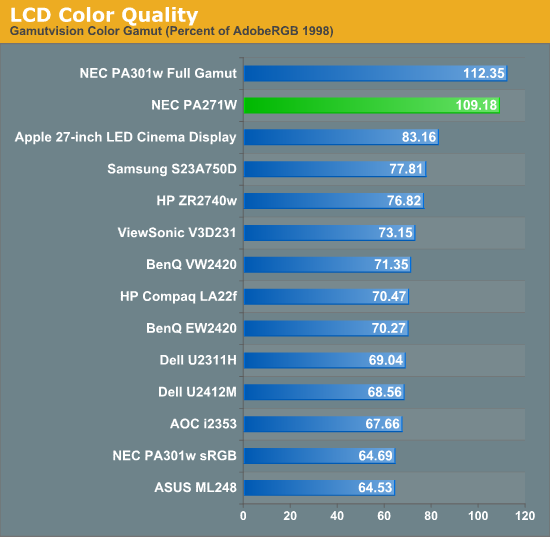


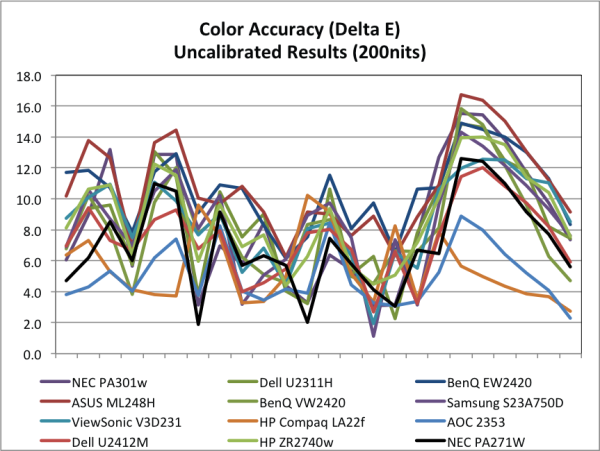
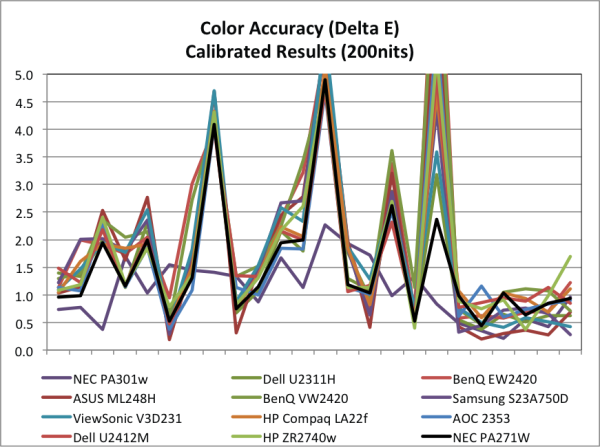









69 Comments
View All Comments
JarredWalton - Tuesday, May 1, 2012 - link
Brian Klug is working on a review I believe. Stay tuned....B3an - Wednesday, May 2, 2012 - link
Next time can you or Brian in his future review mention the fact that these are 16:10 junk, instead of 16:9, and point out why this is so stupid for the area these monitors are aimed at (they should be 2560x1600 res!). Many of which will be people that work in some area of design and would benefit from extra pixels.These things are not for watching movies. For almost anything else including basic things like viewing this very web page, the extra vertical pixels are better.
ectoplasmosis - Wednesday, May 2, 2012 - link
If you're going to go on a bizarre rant, at least make sure you've got your aspect ratios the right way round.theoryzero - Tuesday, May 1, 2012 - link
NEC's page mentions "Rapid Response" or "Response Improve" feature that can be enabled using the MultiProfiler software. Does that feature help with the processing lag?Senti - Tuesday, May 1, 2012 - link
It doesn't. It enables panel overdrive. With it it becomes one of the fastest IPS panels I've seen, but you also get quite bad overdrive artifacts.weiln12 - Tuesday, May 1, 2012 - link
You mention for gaming the HP is the best bet, yet it's worse in lag than the Apple 27". From my quick perusal of the charts appeared to be worse in most categories for color reproduction and everything else.The prices don't seem that far off either based on a cursory Google search of the HP ZR2740w and Apple's given prices.
Could you mind clarifying why the HP is the best bet for gaming, is there something I'm missing?
cheinonen - Tuesday, May 1, 2012 - link
The Apple only works with Thunderbolt, so that's not going to be an option for most gamers, who still use a PC and not a Mac. The HP is incredibly close to the Apple in most numbers, and the lag measurement used for the HP is far more accurate than the one used for the Apple, so they could be closer than the charts indicate.ectoplasmosis - Wednesday, May 2, 2012 - link
The Thunderbolt version isn't the only one available.I'm using a displayport 27" Cinema Display connected to both a PC (DVI) and Mac Pro (mDP) via an mDP KVM switch. By far the best screen I've ever laid eyes on, and crystal-clear with no horrible murky anti-glare coating like almost every other 2560x1440 27" screen.
AeroWB - Wednesday, May 2, 2012 - link
The high gloss display of Apple screen may look fancy and give more punch to the colors, but it can be extremely annoying depending on the room lighting and even in a medium lit room high gloss displays are extremely bad when displaying dark content, as you will see your own reflexion more clearly then the content being displayed.Glossy displays do work well in very dark rooms, but I doubt it is good to work in a dark room and stare into a big light. I do not think it is a coincidence that all professional displays and laptops are non-gloss and in general getting a non-gloss display is the safer option. If color is important glossy screens are a very bad option even if you're careful with the room lighting. it seems to me gloss is so prevalent in the consumer space as it is cheaper to built and looks fancier when displaying bright content. Though it must be said those non-glare coatings do have some influence on the brightness and sharpness of the display though after using my PA241W for about a year I am very happy I did not get the glossy Apple display (which a friend of mine has)
ectoplasmosis - Wednesday, May 2, 2012 - link
The room my ACD's in is far from dark, but is arranged so that screen reflections are a complete non-issue, even with darker content.If you've got control over your environment and lighting then a glossy screen, like you say, gives better contrast, saturation and colour accuracy than an equivalent panel with fuzzy anti-glare coating.
I know which one I prefer, and it's not about looking "fancy" in the least.